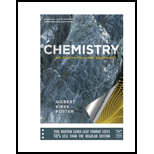
To find:
The balanced chemical equations for the following reactions(in slightly acidic medium)
a)
b)
c)
Answer to Problem 8.99QA
Solution:
a)
b)
c)
Explanation of Solution
1) Concept:
The following steps are followed to balance a
i) Calculate the change in oxidation number values of elements which are getting reduced and oxidized.
ii) Insert the appropriate coefficient to balance the change in oxidation number values(∆O.N) before the species which are getting reduced and oxidized only. We don’t balance O atoms in this step.
iii) The ionic charges are balanced by adding appropriate number of H+ ions in an acidic solution.
iv) Water molecules have to be added, if necessary, in the last step.
2) Calculation:
a)
i) A preliminary expression of the unbalanced
ii) An analysis of change in oxidation number values(∆O.N) is done for Cl and S.
O.N for Cl in
Change in O.N (∆O.N) of Cl = -1
O.N for S in SO2 is +4 and that of S in SO42- is +6.
Change in O.N (∆O.N) of S = +2
iii) To balance these (∆O.N) values we put coefficient 2 in front of ClO3- and 1 in front of SO2.
iv) To balance Cl atoms on both sides, we insert 2 before ClO2.
The above equation is a balanced chemical equation where the electrical charges on both sides are same. (-2 on both left and right side)
b)
i) A preliminary expression of the unbalanced chemical reaction involving reactant and product is:
ii) An analysis of change in oxidation number values(∆O.N) is done for Cl atoms for both reactants.
O.N for Cl in
Change in O.N (∆O.N) of Cl = -1
O.N for Cl in Cl- is -1 and that of Cl in Cl2 is zero.
Change in O.N (∆O.N) of Cl (for each Cl atom) = +1
For two Cl atoms (∆O.N) = +2
iii) To balance these (∆O.N) values we put coefficient 2 in front of
iv) To make Cl equal in both sides, we insert coefficient 2 in front of Cl-
v) To balance O atoms (6 on left and 4 on right side) we add 2 molecules of H2O on right side.
vi) To balance the electrical charges (-4 on left and zero on right) we add 4H+on left side.
(Since the solution is acidic)
This above reaction is the final balanced equation.
c)
i) A preliminary expression of the unbalanced chemical reaction involving reactant and product is:
ii) To analyze the (∆O.N) for Cl2 we put Cl- on the right side.
iii) An analysis of change in oxidation number values(∆O.N) is done for Cl atoms for both reactants.
O.N for Cl in
Change in O.N (∆O.N) of Cl = -1
O.N for Cl in Cl2 is -1 and that of Cl in Cl- is zero.
Change in O.N (∆O.N) of Cl (for each Cl atom) = -1
For two Cl atoms (∆O.N) = -2
iv) To balance these (∆O.N) values we put coefficient 2 in front of ClO3- and 1 in front of Cl2.
v) To balance Cl atoms, we insert coefficient 2 in front of both ClO2 and Cl-.
This is our final balanced chemical equation.(Electrical charge on both sides is -2)
Conclusion:
The given reactions are balanced in the acidic medium using the rules for balancing redox reactions.
Want to see more full solutions like this?
Chapter 8 Solutions
Chemistry: An Atoms-Focused Approach
 ChemistryChemistryISBN:9781305957404Author:Steven S. Zumdahl, Susan A. Zumdahl, Donald J. DeCostePublisher:Cengage Learning
ChemistryChemistryISBN:9781305957404Author:Steven S. Zumdahl, Susan A. Zumdahl, Donald J. DeCostePublisher:Cengage Learning ChemistryChemistryISBN:9781259911156Author:Raymond Chang Dr., Jason Overby ProfessorPublisher:McGraw-Hill Education
ChemistryChemistryISBN:9781259911156Author:Raymond Chang Dr., Jason Overby ProfessorPublisher:McGraw-Hill Education Principles of Instrumental AnalysisChemistryISBN:9781305577213Author:Douglas A. Skoog, F. James Holler, Stanley R. CrouchPublisher:Cengage Learning
Principles of Instrumental AnalysisChemistryISBN:9781305577213Author:Douglas A. Skoog, F. James Holler, Stanley R. CrouchPublisher:Cengage Learning Organic ChemistryChemistryISBN:9780078021558Author:Janice Gorzynski Smith Dr.Publisher:McGraw-Hill Education
Organic ChemistryChemistryISBN:9780078021558Author:Janice Gorzynski Smith Dr.Publisher:McGraw-Hill Education Chemistry: Principles and ReactionsChemistryISBN:9781305079373Author:William L. Masterton, Cecile N. HurleyPublisher:Cengage Learning
Chemistry: Principles and ReactionsChemistryISBN:9781305079373Author:William L. Masterton, Cecile N. HurleyPublisher:Cengage Learning Elementary Principles of Chemical Processes, Bind...ChemistryISBN:9781118431221Author:Richard M. Felder, Ronald W. Rousseau, Lisa G. BullardPublisher:WILEY
Elementary Principles of Chemical Processes, Bind...ChemistryISBN:9781118431221Author:Richard M. Felder, Ronald W. Rousseau, Lisa G. BullardPublisher:WILEY





